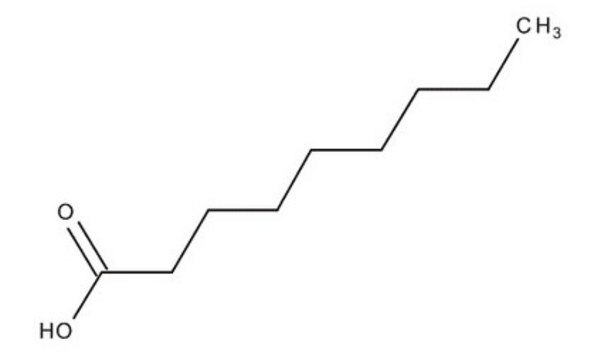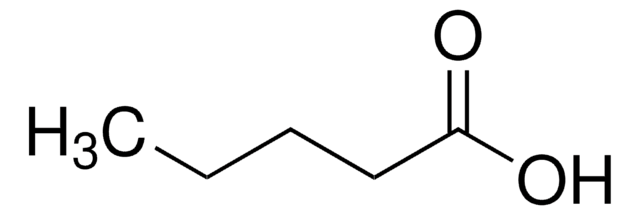N5502
Nonanoic acid
≥97%
Synonym(s):
Acid C9, Pelargonic acid
About This Item
Recommended Products
vapor density
5.5 (vs air)
Quality Level
vapor pressure
<0.1 mmHg ( 20 °C)
assay
≥97%
form
liquid
expl. lim.
9 %
refractive index
n20/D 1.432 (lit.)
bp
268-269 °C (lit.)
mp
9 °C (lit.)
density
0.906 g/mL at 25 °C (lit.)
functional group
carboxylic acid
lipid type
saturated FAs
shipped in
ambient
storage temp.
2-8°C
SMILES string
CCCCCCCCC(O)=O
InChI
1S/C9H18O2/c1-2-3-4-5-6-7-8-9(10)11/h2-8H2,1H3,(H,10,11)
InChI key
FBUKVWPVBMHYJY-UHFFFAOYSA-N
Looking for similar products? Visit Product Comparison Guide
Application
- Qualitative and Quantitative Metabolite Comparison of Korean Traditional Alcoholic Beverages: Takju, Yakju, and Traditional-Soju.: Uses nonanoic acid to analyze and compare the metabolic profiles of traditional Korean alcoholic beverages, aiding in the preservation of cultural heritage and improving product quality (Tak et al., 2024).
- In Vitro Evaluation of Essential Oils and Saturated Fatty Acids for Repellency against the Old-World Sand Fly, Phlebotomus papatasi (Scopoli) (Diptera: Psychodidae).: This research explores nonanoic acid′s potential as a natural repellent, contributing to the development of safer and more effective control measures against vector-borne diseases (Temeyer et al., 2024).
signalword
Warning
hcodes
Hazard Classifications
Eye Irrit. 2 - Skin Irrit. 2
Storage Class
10 - Combustible liquids
wgk_germany
WGK 1
flash_point_f
278.6 °F - Pensky-Martens closed cup
flash_point_c
137 °C - Pensky-Martens closed cup
ppe
Faceshields, Gloves, Goggles, type ABEK (EN14387) respirator filter
Certificates of Analysis (COA)
Search for Certificates of Analysis (COA) by entering the products Lot/Batch Number. Lot and Batch Numbers can be found on a product’s label following the words ‘Lot’ or ‘Batch’.
Already Own This Product?
Find documentation for the products that you have recently purchased in the Document Library.
Customers Also Viewed
Protocols
In this study, SPME was used for the analysis of free fatty acids in Parmesan cheese using a 65 μm Carbowax/divinylbenzene (DVB) SPME fiber. Headspace extraction of the cheese sample was conducted at 65 °C for 15 minutes and analyzed by GC with FID detection. SPME is ideal for analyzing the volatiles associated with solid food samples. The phase chemistry of the Nukol GC column provides excellent peak shape of acidic compounds.
Our team of scientists has experience in all areas of research including Life Science, Material Science, Chemical Synthesis, Chromatography, Analytical and many others.
Contact Technical Service










